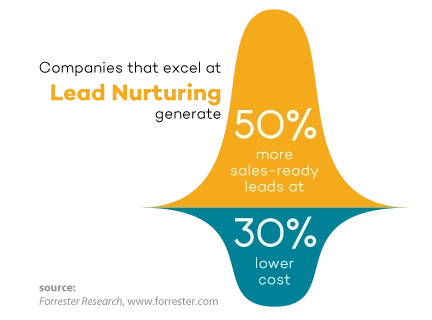How to Generate and Convert More Leads Using 5 Simple Steps in 2025
Leads are the lifeblood of any business. As a B2B company, generating leads is crucial to grow sales and revenues. However, it's not enough to just attract leads, you need to convert them into paying customers.
In this comprehensive guide, we will explore powerful strategies and tactics that will help your B2B company attract quality leads and convert them into loyal customers. By implementing the right techniques, you can significantly grow your sales and revenues.
We'll cover essential concepts such as lead magnets, SEO, and effective lead conversion strategies. Whether you're a CEO, Sales manager, or Marketing manager, this guide will equip you with the knowledge and strategies to drive successful lead generation campaigns.
Step 1: Create a Lead Magnet to Engage and Capture Leads

1.1 What Are Lead Magnets?
Lead magnets are valuable resources or incentives offered to potential leads in exchange for their contact information (such as email address). They are designed to attract and engage your target audience, providing them with relevant and useful content that addresses their pain points or solves their problems.
1.2 Types of Lead Magnets
The various types of lead magnets you can create to capture leads effectively are:
- eBooks,
- whitepapers,
- checklists,
- templates,
- webinars,
- free trials,
- exclusive access to premium content.
Choose a lead magnet that aligns with your audience's interests and provides genuine value.
1.3 Creating Effective Lead Magnets
To create compelling lead magnets, start by understanding your target audience and their needs. Conduct thorough research to identify their pain points and create content that offers practical solutions. Focus on delivering high-quality and actionable information. Design visually appealing lead magnets and optimize them for easy consumption and sharing.
For example, if you are B2B SaaS company providing a Project Management solution, you can create a comprehensive eBook that addresses a common challenge that business face in regards to project management. Promote the ebook through your website, social media channels, and email marketing campaigns. By providing valuable insights and actionable strategies, you will significantly increase lead capture, attracting highly engaged prospects.
Step 2: Optimize SEO for Lead Generation: Get Found by the Right Audience
2.1 Understanding SEO for Lead Generation
Search Engine Optimization (SEO) plays a crucial role in driving organic traffic to your website and attracting qualified leads. It involves optimizing your website's structure, content, and keywords to rank higher on search engine results pages. By understanding your target audience's search intent, you can tailor your SEO strategy to attract the right visitors.
2.2 Keyword Research and On-Page Optimization
Start by conducting keyword research to identify the search terms your audience uses when looking for products or services related to your business. Incorporate these keywords naturally into your website's content, meta tags, headings, and URLs. Optimize your website's loading speed, improve mobile responsiveness, and enhance user experience to boost search engine rankings.
2.3 Off-Page SEO Strategies
Off-page SEO refers to actions taken outside of your website to improve its visibility and authority. Off-page SEO strategies:
- Focus on building high-quality backlinks from reputable websites in your industry.
- Engage in guest blogging,
- influencer collaborations,
- social media promotion to increase your online presence and drive traffic back to your site.
2.4 Creating Compelling Landing Pages
A landing page is a web page that is specifically designed to convert visitors into leads. It is where your potential customers land after clicking on your ad or a search engine result. A compelling landing page should have a clear and concise message that highlights the benefits of your products or services.
To create a compelling landing page, you need to keep it simple and clutter-free. Use a clear and concise headline that highlights the benefits of your products or services. Use bullet points to highlight the key features and benefits of your products or services. Include a clear call-to-action (CTA) that encourages visitors to take the desired action, such as filling out a form or making a purchase.
2.5 What factors determine your SEO ranking?
The graph below summarizes the various factors that affect SEO ranking and their relevant weight (Source: FirstPageSage).

You may have heard the old SEO saying: “content is king.” And in the case of Google ranking factors, the quality of your content has a huge impact. Followed by keywords usage, quality backlinks and so on.
Step 3: Leveraging Social Media for Lead Generation: Expand Your Reach
3.1 The Role of Social Media in Lead Generation
Social media platforms offer immense opportunities for B2B companies to connect with their target audience, build brand awareness, and generate leads. Leverage social media to engage with prospects, share valuable content, and establish your brand as an industry thought leader.
3.2 Choosing the Right Platforms
Identify the social media platforms that align with your target audience's preferences and industry presence. For B2B companies, platforms like LinkedIn and Twitter often provide excellent opportunities for networking, sharing industry insights, and connecting with decision-makers. Videos too are highly engaging and have the power to captivate audiences within seconds. Platforms like TikTok and YouTube Shorts provide a perfect environment to showcase your B2B brand in a visually appealing and attention-grabbing manner.

3.3 Creating Compelling Content
Develop a social media content strategy that combines educational, entertaining, and promotional content. Share blog posts, infographics, videos, and industry news that resonate with your target audience. Encourage engagement by posing questions, conducting polls, and hosting live events.
3.4 Paid Advertising on Social Media
Supplement your organic social media efforts with paid advertising campaigns. Utilize targeting options to reach specific demographics, industries, or job titles. Create compelling ad copy and visuals that clearly communicate the value proposition of your services.
Step 4: Nurture and Convert Leads: Strategies That Work
4.1 The Importance of Lead Nurturing
Lead nurturing is the process of building relationships with your leads at each stage of the buyer's journey. It involves delivering personalized and relevant content that guides them towards making a purchase decision. By nurturing your leads, you can increase their trust, engagement, and likelihood of converting into customers

The ROI in lead nurturing is clear- according to Forrester Research of 2018, companies excelling at lead nurturing generated 50% more sales-ready leads, at a 33% lower cost.
And not only does great nurturing result in more sales, but bigger sales too!
4.2 Personalization and Segmentation
Personalization is key to effective lead nurturing. Use marketing automation tools to personalize your communications based on lead behavior, preferences, and engagement history. Segment your leads into specific groups to deliver content that is highly relevant and tailored to their needs, increasing the chances of conversion.
4.3 Crafting Engaging Email Campaigns
Email marketing is a powerful tool for lead nurturing. Create targeted email campaigns that provide value and address your leads' pain points. Segment your email list based on demographics, interests, or behavior to deliver personalized content. Setup an automated drip email campaign to begin nurturing your email subscribers into customers. Include clear and compelling calls-to-action (CTAs) that encourage leads to take the next step in the conversion process.
4.4 Converting Leads into Customers
To convert leads into customers, focus on building trust and addressing their concerns. Provide social proof through testimonials, case studies, and success stories. Offer free trials, demos, or consultations to give leads a firsthand experience of your product or service. Implement lead scoring to identify highly qualified leads for prioritized follow-up.

Step 5: Measure and Optimize Your Lead Generation Efforts: Continuous Improvement
5.1 Key Metrics to Track
Identify and track key performance indicators (KPIs) that align with your lead generation goals. Here are common marketing metrics that you should monitor:
| Website Traffic | Number of visitors on your site. Monitor the trends |
| MQL | A lead who has indicated an interest in what you have to offer based on marketing actions |
| Cost per MQL | Cost to get a Marketing Qualified Lead (MQL) |
| Marketing-sourced Pipeline | The total revenue in the sales pipeline coming from your marketing actions |
| Lead Quality | The ratio of number of MQL to the total number of leads generated |
| Conversion rate | The percentage of MQL converted into buying customers. |
| Total Revenue | The total revenue generated by the deals coming from your marketing actions |
| ROI | The profit earned from every dollar your business spends on marketing efforts over a period of time (e.g. quarterly/semi-annually/annually) |
Use analytics tools to monitor these metrics and gain valuable insights into the effectiveness of your campaigns.
5.2 Analyzing and Interpreting Data
Regularly analyze and interpret the data collected from your lead generation efforts. Identify patterns, trends, and areas for improvement. Understand which strategies and channels are driving the most leads and conversions, and adjust your approach accordingly.

5.3 A/B Testing and Conversion Rate Optimization
Conduct A/B tests to optimize your landing pages, email campaigns, and ad copy. Test different elements such as headlines, CTAs, visuals, and form fields to identify what resonates best with your audience. Continuously optimize your conversion rates to maximize the number of leads that convert into customers.
Five effective ways to generate and convert leads: Conclusion
Generating and converting leads is a fundamental aspect of B2B marketing. By implementing the strategies outlined in this beginner's guide – utilizing lead magnets, optimizing SEO, nurturing leads, leveraging social media, and measuring and optimizing your efforts – you can drive successful lead generation campaigns. Remember to tailor your approach to your target audience, continuously analyze data, and adapt your strategies as needed. With dedication and a focus on providing value, you can attract quality leads and convert them into loyal customers, leading to the growth of your sales and revenues. Check out our consulting services if you need a little help with your lead generation strategy.
You can book a FREE consultation with our marketing strategist here.
Have you tried any lead generation strategies for your business? Which ones worked best for you?



